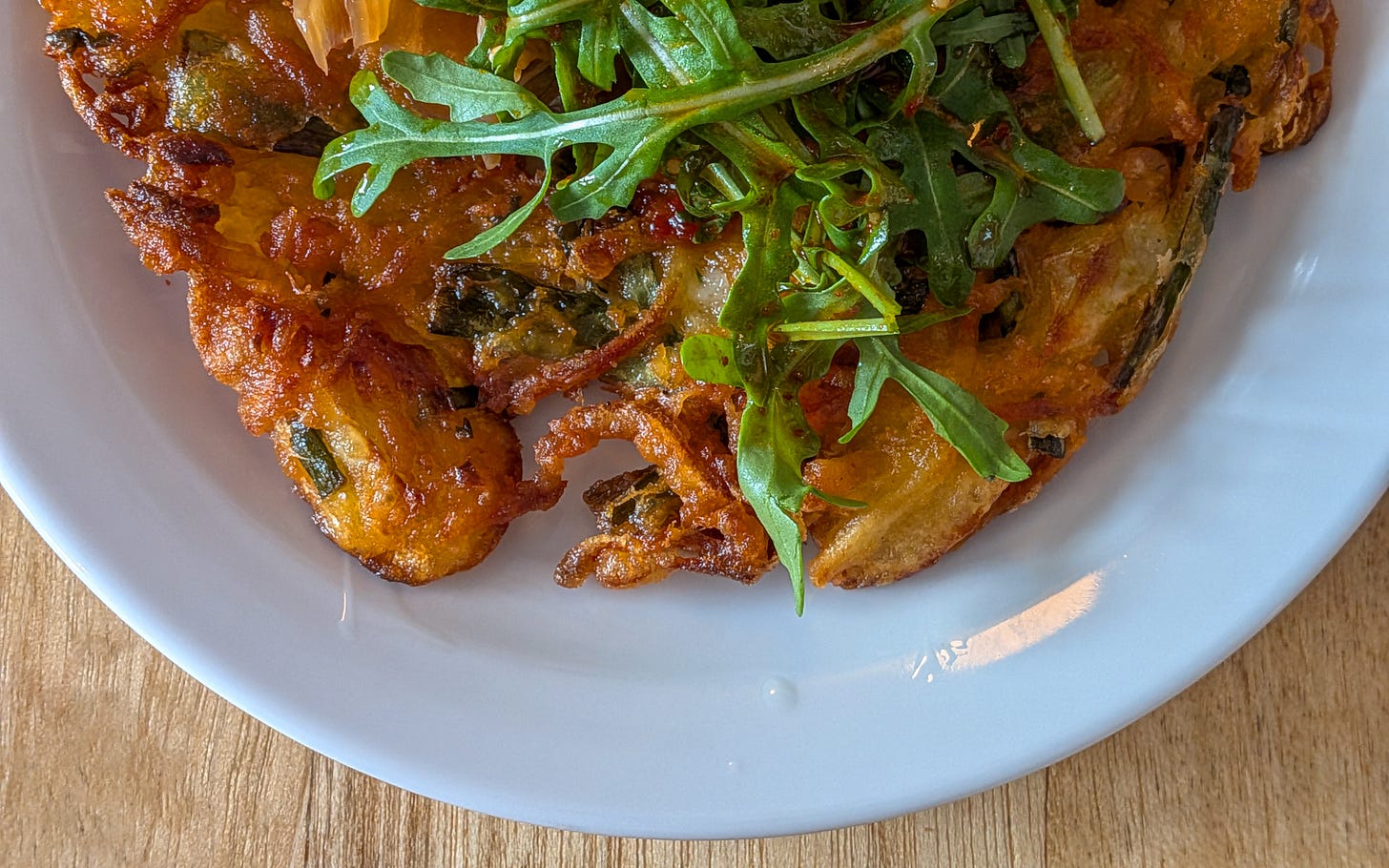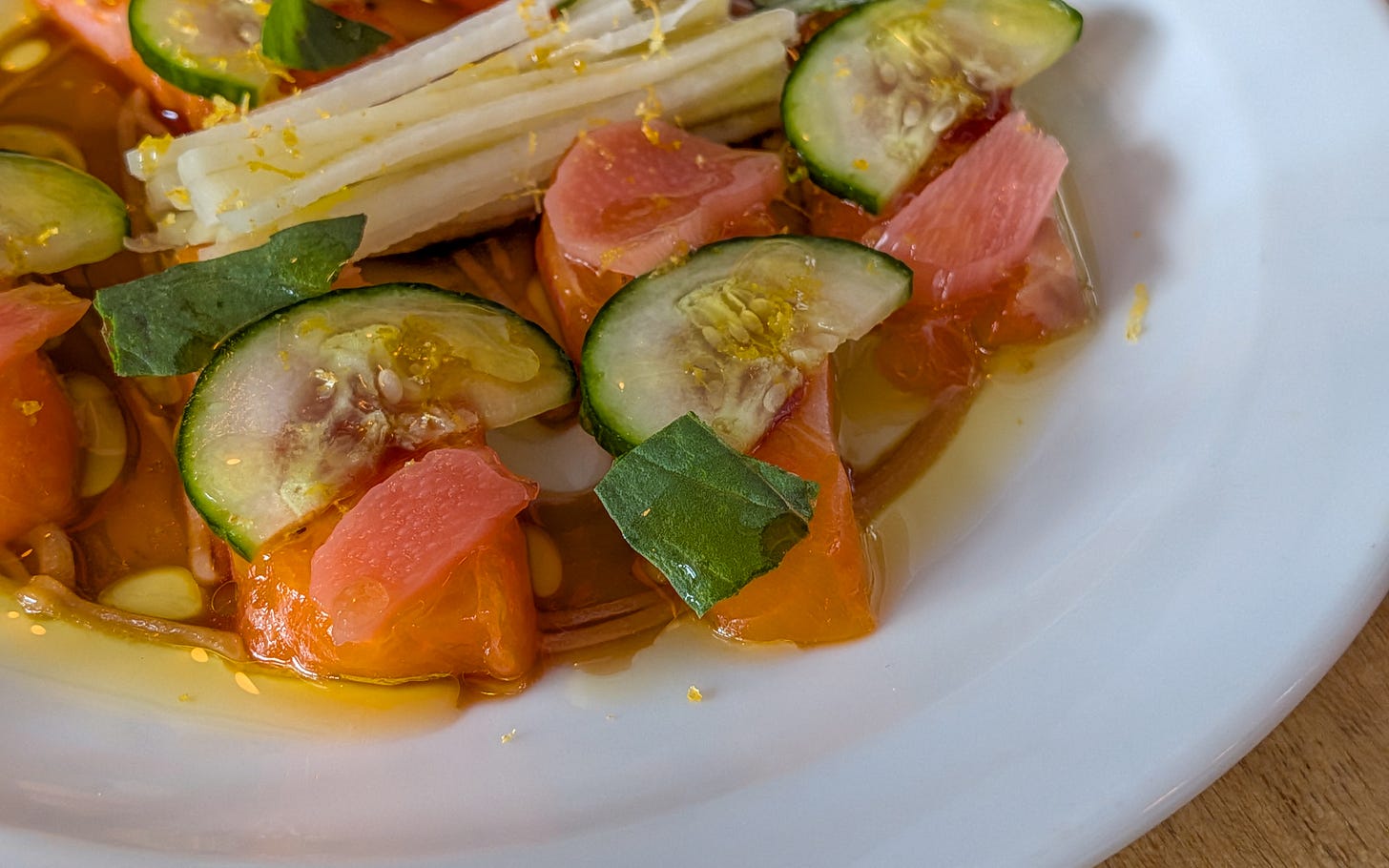I visited Calong in the same way I visit too many restaurants: at best dimly aware of why it was on my radar in the first place, knowing only that at some point, for some reason, I saved it to the sprawling Google Maps list that manages my every meal out.
But a friend was in the same boat, and so a lunch plan was made, and after cursory research (...looking at a few photos on the Maps listing) we each agree that Calong is probably a lot like Miga: a neighbourhood Korean restaurant with a few modern touches and mid-market pricing.
We were right; but also quite, quite wrong.
Calong only opened in February this year, but head chef Joo Young Won has been developing the concept across pop-ups and supper clubs since 2020, long before setting up shop in Stoke Newington. That probably sets an idea of Won in your head: perhaps he made his money in finance or law before giving it up to follow his dream; maybe he’s a plucky young chef with a couple years’ experience ready to make his own way; or just a passionate home cook hoping to bring well-worn family recipes to a wider audience.
Won, in fact, worked at the Michelin-starred Galvin at Windows for 15 years, seven of them as head chef. He’s no bushy-tailed young upstart hoping to make a name for himself, but an industry veteran carving his own path by revisiting the food of his youth in Busan. And his decades of experience show, at times unexpectedly: this is Korean food by way of French fine dining, kimchi meets cordon bleu.
There’s even a giveaway from minute one if you’re attentive enough to notice: there’s not a chopstick in sight, each table laid with knife and fork instead. That’s about as strong an indication as you’ll find that Won doesn’t see Calong as just another Korean restaurant, that it has different aspirations to Miga.
The fine dining influence is more obvious in some dishes than others. Sea trout hwe — thin-sliced raw fish, or “Korean sashimi” if you feel like irritating two countries’ worth of people at once — arrives in a pool of sesame oil and plum soy, each sliver of fish topped by morsels of cucumber and sharp rhubarb. The balance is a little off — the trout overpowered by the soy and rhubarb, lost in a dish where it should be the star — but the delicacy of the plating is Galvin all the way down.
The short dessert and cheese list makes matters even more obvious. I don’t think there’s a whole lot of comté in traditional Korean cuisine, though a side of ginseng honey gives the requisite nod. We order a chocolate cremeux, its indulgence tempered by juicy chunks of blood orange and balanced by a scoop of roasted tea ice cream balanced gently on top. In indelicate hands this could be a jarring mess; here it’s a fitting finale to an impressive meal.
Still, if you ordered differently and skipped dessert, you might not spot Won’s Michelin-studded past so clearly. Neither kimchi fritters nor a vegetable pancake stray too far from the jeon you’ll find in Seoul’s food markets unless you look closely at the details: a chilli mayo served beside the fritters; the inclusion of fennel in the pancake. Both are fried as well as I’ve ever had them, crisp and light, without a hint of doughiness.
Grilled mackerel and braised daikon radish would be an archetypal Korean plate were it not joined by seasonal wild garlic, while the braised pork shoulder jjim could only seem more authentic if it was served on a bed of rice rather than crushed potatoes, a connective tissue to Western stew sensibilities. The pork is, frankly, revelatory, and suffers only from the fact that Calong’s seasonal menu probably dooms it to disappear by the time I make it back for round two. This is no dish of textural contrasts and unexpected combinations: it’s a platter full of achingly soft things, cooked down into one unutterably comforting bowl of brown. If I knew how to cook this, I wouldn’t often eat anything else.
It’s also, in its own simple way, a good encapsulation of what Calong offers at its best. Dishes that draw primarily from Korean home comforts, tweaked by elevated techniques and Western ingredients, but not so much that they lose sight of where they came from. Perhaps just as importantly, they’re served in generous portions. I’m not saying Calong is the sort of place where a tenner gets you a full meal, but if all the mentions of fine dining got your hackles up about itty bitty portions and sky high prices, there’s no real sign of either here.
If there’s a downside to it all, it’s that at times that Korean-European crossover feels a little confused, especially at its more European end. And you’ll have to order with a bit of an open mind, since dishes like the sea trout hwe might not turn up looking quite like you expect. But Won’s kitchen is putting out excellent, inventive food, priced without pretension, and if the worst you can expect is a surprise or two then that’s not a bad deal at all.







